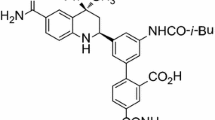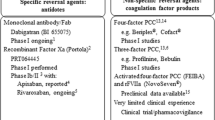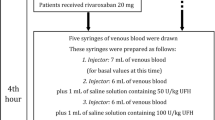Abstract
Deep venous thrombosis (DVT) is a common cardiovascular disease, resulting in significant mortality each year in the United States. Direct thrombin inhibitors represent a new class of drugs that could potentially be better than conventional antithrombotic therapy based on indirect inhibition of coagulation factors with heparin and warfarin. BCH 2763 is a potent, selective bifunctional thrombin inhibitor that blocks both the active catalytic site and the anion binding exosite. The objective of this study is to test the antithrombotic efficacy of BCH 2763 in a canine model of DVT induced through electrolytic injury to the femoral vein. BCH 2763 was administered at three dose levels: 0.125 mg/kg bolus followed by 10 µg/kg/min IV infusion (low-dose; n = 5), 0.25 mg/kg bolus followed by 20 µg/kg/min infusion (mid-dose; n = 5), and 0.75 mg/kg bolus followed by 60 µg/kg/min (high-dose; n = 5). The control group (n = 5) received a 5-ml intravenous bolus of saline followed by a 1 mL/kg/h infusion. The parameters evaluated were changes in activated partial thromboplastin time (aPTT), thrombin time (TT), prothrombin time (PT), time to formation of an occlusive thrombus in the femoral vein, and the amount of venous blood flow delivered over the course of the experiment. There were significant dose-dependent increases in aPTT, TT, and PT in the BCH 2763-treated animals compared with the control group. The time to formation of an occlusive thrombus in the control group averaged 69.6 ± 9 minutes. Treatment with BCH 2763 prolonged the time to occlusion to 126.4 ± 13 minutes in the low-dose group, 155.4 ± 17 minutes in the mid-dose group, and 229 ± 7 minutes in the high-dose group (80% remained patent for the duration of the study), which were all significantly greater than the controls. Femoral venous blood flow was significantly greater in the mid-dose (51 ± 8%) and the high-dose (70 ± 6%) groups compared with the control vessels (22 ± 3%). In conclusion, the results of this study indicate that BCH 2763 is an effective intravenous antithrombotic agent in the canine electrolytic injury model of venous thrombosis.
Similar content being viewed by others
References
Anderson FA, Wheeler HB, Goldberg RJ, et al. A population-based perspective of the hospital incidence and case-fatality rates of deep vein thrombosis and pulmonary embolism. Arch Intern Med 1991;151:933–938.
Hirsh J, Hoak J. Management of deep vein thrombosis and pulmonary embolism: A statement for healthcare professionals. Circulation 1996;93:2212–2245.
Ginsberg JS. Management of venous thromboembolism. N Engl J Med 1996;335:1861–1828.
Pearson SD, Lee TH, McCabe-Hassan S, Dorsey JL, Gold-haber SZ. A critical pathway to treat proximal lower-extremity deep vein thrombosis. Am J Med 1995;100:283–289.
Harker LA, Hanson SR, Runge MS. Thrombin hypothesis of thrombus generation and vascular lesion formation. Am J Cardiol 1997;75:12B–7B.
Lefkovits J, Topol EJ. Direct thrombin inhibitors in cardiovascular medicine. Circulation 1994;90:1522–1536.
Philippides GJ, Loscalzo J. Potential advantages of directacting thrombin inhibitors. Cor Art Dis 1996;7:497–507.
Finkle C, St-Pierre A, Leblond L, Deschenes I, DiMaio J, Winocour PD. BCH-2763, a novel potent parenteral thrombin inhibitor, is an effective antithrombotic agent in rodent models of arterial and venous thrombosis; comparisons with heparin, r-hirudin, hirulog, inogatran and argatroban. Thromb Haemost 1998;79:431–438.
DiMaio J, Gibbs B, Lefebvre J, Konishi Y, Munn D, Yue S. Synthesis of a homologous series of ketomethylene arginyl pseudodipeptides and application to low molecular weight hirudin-like thrombin inhibitors. J Med Chem 1992;35: 3331–3341.
Sudo Y, Lucchesi BR. Antithrombotic effect of GYKI-14766 in a canine model of arterial and venous rethrombosis: A comparison with heparin. J Cardiovasc Pharmacol 1996;27: 545–555.
DiMaio J, Winocour PD, Leblond L, Saifeddine M, Laniyonu A, Hollenberg MD. Thrombin inhibitors and thrombin receptor agonists/antagonists. Perspectives in receptor research. Perspect Receptor Res 1996;24:271–289.
Buchanan MR, Brister SJ, Finkle C, DiMaio J, Winocour PD. Inhibition of thrombin generation and platelet activation during cardiopulmonary bypass (CPB) in pigs. Haemostasis 1996;26:131.
Catella-Lawson F. Direct thrombin inhibitors in cardiovascular disease. Cor Art Dis 1997;8:105–111.
Turpie AGG, Weitz JI, Hirsh J. Advances in antithrombotic therapy: Novel agents. Thromb Haemost 1995;74:565–571.
Weitz J. New anticoagulant strategies. Drug 1994;48: 485–497.
Hermann JP, Kutryk MJB, Serruys PW. Clinical trials of direct thrombin inhibitors during invasive procedures. Thromb Haemost 1997;78:367–376.
White HD. Thrombin hypothesis: The TIMI 9B and GUSTO IIB trials have successfully disproven/proven the thrombin hypothesis. J Thrombo Thromboly 1997;4:317–319.
Ginsberg JS, Nurmohamed MT, Gent M, et al. Use of hirulog in the prevention of venous thrombosis after major hip or knee surgery. Circulation 1994;90:2385–2389.
Eriksson BL, Kalebo P, Ekman S, Lindbratt S, Kerry R, Close P. Direct thrombin inhibition with Rec-hirudin CGP39393 as prophylaxis of thromboembolic complications after total hip replacement. Thromb Haemost 1994;72: 227–231.
Verstraete M. Direct thrombin inhibitors: Appraisal of the antithrombotic/hemorrhagic balance. Thromb Haemost 1997;78:357–363.
Rebello SS, Miller B, Basler GC, Lucchesi BR. CVS-1123, a direct thrombin inhibitor, prevents occlusive arterial and venous thrombosis in a canine model of vascular injury. J Cardiovasc Pharmacol 1997;29:240–249.
Author information
Authors and Affiliations
Rights and permissions
About this article
Cite this article
McClanahan, T.B., Ignasiak, D.P., Juneau, P. et al. Antithrombotic Effects of BCH 2763, a New Direct Thrombin Inhibitor, in a Canine Model of Venous Thrombosis. J Thromb Thrombolysis 7, 301–306 (1999). https://doi.org/10.1023/A:1008987211850
Issue Date:
DOI: https://doi.org/10.1023/A:1008987211850




